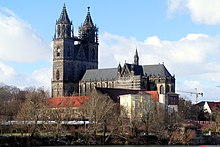The Magdeburg Börde lies in the central Saxony-Anhalt and extends west of the Elbe with the center of the state capital Magdeburg. The Börde is known for its extremely fertile loess soils and black earths, which formed the economic basis for an enormous cultural and architectural wealth. Numerous Romanesque buildings are evidence of this.
To the north the Börde goes into the river Ohre Altmark above, in the east the Elbe forms a clear demarcation. In contrast, the boundaries to the west and south are somewhat blurred due to the lack of prominent natural spatial fixed points and are defined differently. Here, for the sake of simplicity, the national border is drawn Lower Saxony as western limit that resin to the southwest and the lowland as part of the Börde to demarcate it from the lower Saale valley scheduled.
places


- 1 Magdeburg - State capital of Saxony-Anhalt; Magdeburg Cathedral.
- 2 Aschersleben - former Hanseatic city.
- 3 Halberstadt - the "gateway to the Harz"; Gothic cathedral St. Stephen and St. Sixtus.
- 4 Schönebeck - Located 15 km south of the state capital Magdeburg; Spa in the Bad Salzelmen district.
- 5 Staßfurt - City of potash mining.
- 6 Leeches -
- 7 Haldensleben - District town of the Ohrekreis located on the Mittelland Canal.
- 8 Hecklingen -
- 9 Oschersleben - formerly the district town of the Bördekreis and now part of the Börde district.
- 10 Wanzleben - Wanzleben Castle from the 13th century.
- 11 Wolmirsleben -
- 12 Wolmirstedt -
- 13 Zielitz - Rock salt extraction with a landscape-defining spoil dump, the Kalimanjaro
Other goals
- Colbitz-Letzlinger Heide - the transition area to Altmark.
- Lowland - in the southwest of the Börde, at the transition to the Harz foreland and the Lower Saale Valley. Landscape protection area with arable, open cultural landscape (approx. 73 km²); The most natural section is between Staßfurt and the confluence of the Bode in the Saale near Nienburg.
background

The Magdeburger Börde belongs to a large extent to the Elbe lowlands. The landscape is mostly gently undulating without any distinctive terrain. The use is strongly influenced by agriculture - not surprisingly, the Magdeburger Börde has the most fertile soils in Germany. In the Middle Ages, the Christianization of the Slavs began in Magdeburg and the associated eastward expansion of the Holy Roman Empire.
getting there
By plane
The nearest international airports are the Leipzig / Halle Airport![]() (IATA: LEJ), Hanover-Langenhagen Airport
(IATA: LEJ), Hanover-Langenhagen Airport![]() (IATA: HAJ), Berlin Brandenburg Airport
(IATA: HAJ), Berlin Brandenburg Airport![]() (IATA: BER).
(IATA: BER).
By train
The most important train station in the region is Magdeburg Hbf. Intercity trains from Leipzig and Hanover stop here every hour, and every two hours from Dresden, Cologne / Ruhr area and Bremen / Oldenburg; as well as an hourly regional express from Berlin. In Magdeburg you can change to regional trains, the S-Bahn Mittelelbe or regional buses to other places on the Börde.
The Deutsche Bahn also operates the regional train after Braunschweig (every hour on weekdays, every two hours on weekends) stops in Eilsleben. All other regional trains are operated by Abellio Rail Central Germany operated. So you can come from direction Hall hourly, from Goslar Every two hours, their regional express trains go directly to Aschersleben and Halberstadt. Of Erfurt the regional express takes you to Staßfurt and Schönebeck every two hours. The RB off Wolfsburg stops every hour in Haldensleben. From Berlin or Potsdam there are only connections with the Harz-Berlin-Express on weekends without changing in Magdeburg to Oschersleben or Halberstadt.
By car
The A 2 Hanover - Berlin motorway crosses the region in an east-west direction. From the south (Halle / Leipzig) comes the A 14, which currently ends a little north of Magdeburg.
mobility
Large parts of the "Magdeburger Börde" region are in the tariff area of the transport association "marego". Specifically, in addition to the city of Magdeburg, these are the surrounding districts of Börde (Oschersleben, Haldensleben, Wanzleben, Wolmirstedt), Jerichower Land (Burg, Genthin) and the Salzlandkreis (Schönebeck, Stassfurt, Bernburg, Aschersleben). Travelers with network tickets can use all public transport in the respective tariff zone. The Saxony-Anhalt ticket (as well as the Saxony and Thuringia ticket) is also valid on buses and trams in addition to the train.
Tourist Attractions
The themed route Romanesque Road connects a number of Romanesque sacred buildings, from the Magdeburg Cathedral or Halberstadt Cathedral to the Romanesque village church. The Magdeburger Börde is the central part of this road that leaves the Börde to the north and south.
There are also numerous castles, mansions, gardens and parks that bear witness to the prosperity of the fertile landscape.
activities
kitchen
nightlife
security
climate
The Magdeburger Börde is located in the transition area between marine / Atlantic and continental influence. This means that the winters tend to be cooler and the summers warmer than the German average. The rain shadow of the Harz is noticeable, so that the Börde is one of the regions with the lowest rainfall in Germany.



